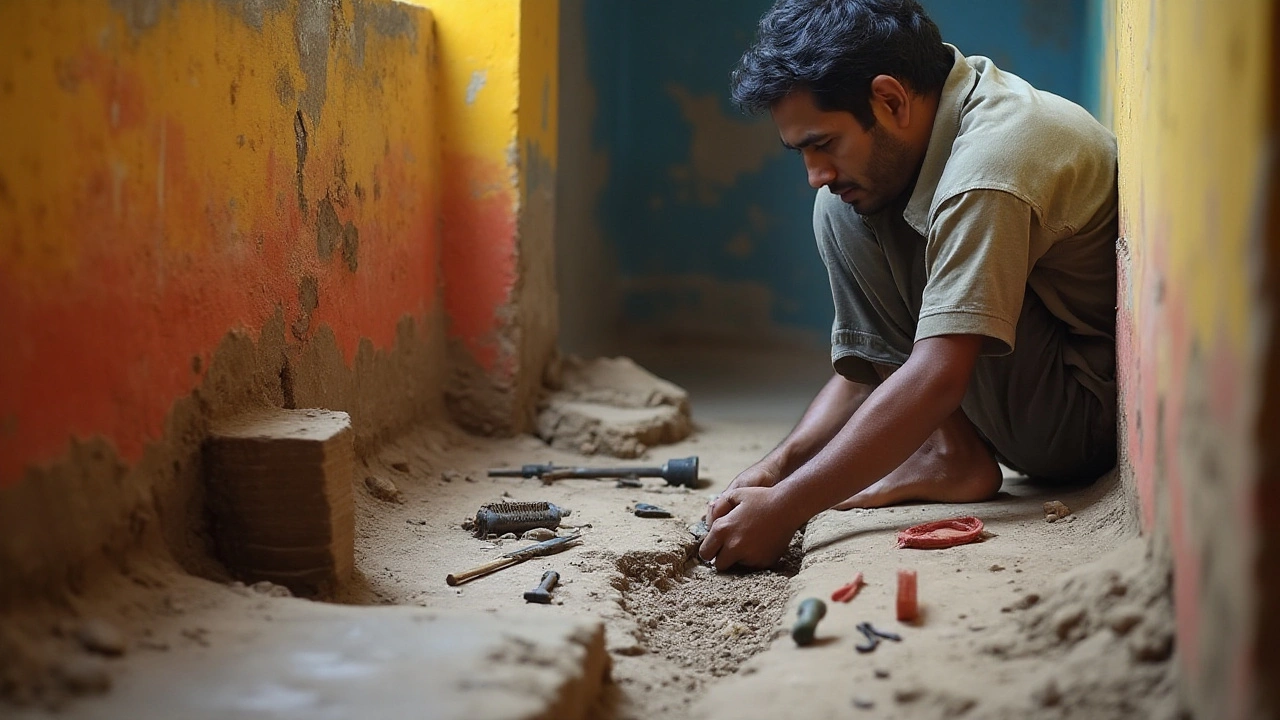Surviving With a Cracked Foundation: Essential Insights

Living in a home with a cracked foundation can be unnerving, but it's not always an immediate cause for panic. Foundations are the bedrock of any structure, and their health is essential for ensuring safety and stability. However, not all cracks spell disaster. Some are harmless, while others might be indicators of underlying issues.
As a homeowner, knowing the difference is key to making informed decisions. You'll want to understand the various types of foundation cracks and what they could mean for your property. While some can be managed with simple interventions, others may require professional repairs to avert potential risks.
This article dives into the details of living with a cracked foundation, assessing necessary repairs, and ensuring the safety of your home. Being proactive and informed will help you maintain the structural integrity of your house, keeping it safe and sound for years to come.
- Understanding Foundation Cracks
- Signs of Trouble: When to Worry
- Potential Risks of a Cracked Foundation
- Repair Options and Costs
- Preventive Measures for Homeowners
Understanding Foundation Cracks
Foundations are to houses what roots are to trees: they are crucial for stability and strength. When those roots start showing cracks, it's natural to feel a mix of curiosity and concern. Not all cracks are created equal, and understanding their origins can help assess whether your home is in trouble or just experiencing some wear and tear. Foundation cracks can appear for various reasons, ranging from natural settling to external pressures. These cracks can be a cosmetic issue or a sign of structural movement. Cracked foundation aren't uncommon, especially in areas with significant seasonal changes, where temperatures and moisture levels vary drastically.
The earliest stage of cracking often presents itself as hairline fractures. These are typically harmless and born from the home's natural settling process. As a new house adapts to its environment, slight shifts can create these thin lines. However, vertical cracks are often seen in a more positive light compared to their horizontal or diagonal counterparts, which may indicate increased external pressure on the walls, potentially signaling a more serious problem. Identifying and categorizing the type of crack, including its size, shape, and location, is crucial as this can guide you to the next steps for foundation repair.
Interestingly, a 2019 study from the American Society of Civil Engineers noted that about 25% of U.S. homes experience some form of structural distress, with foundation issues being among the top concerns. Understanding the geological conditions of your home's location also provides useful clues. For instance, clay soils tend to expand and contract with moisture content, leading to cyclical pressures on the foundation. Conversely, sandy soils are more stable but can pose challenges if erosion is present. The science behind these shifts is fascinating, as each soil type interacts uniquely with the structural load placed upon it, similar to how various genres of music resonate differently with an audience.
The condition of the materials used during construction will also significantly influence the foundation's health. A well-constructed foundation crafted from high-quality materials can withstand decades, if not centuries, with minimal issues. Yet, improper installation, use of subpar materials, or inadequate drainage can accelerate wear and lead to more severe cracks. Speaking of drainage, water is often a foundation's worst enemy. Excess moisture can seep into the soil, expanding it and creating unnecessary pressure against the concrete. Thus, effective drainage systems are paramount.
"Water problems in soil are the main cause of foundation troubles," asserts Dr. Leslie Turner, a noted expert in residential construction.
Homeowners should engage in regular maintenance checks, observing any changes that might indicate the cracks are more than just cosmetic. Having a comprehensive understanding of what makes your home tick—like a doctor acquainted with a patient's history—enables you to better predict and manage potential issues. It's all about being preventive rather than reactive, which is not only cost-effective but also lessens stress in the long run. Knowledge is, after all, the first line of defense in protecting what is often your most significant investment: your home.
Signs of Trouble: When to Worry
Your house is more than just a physical structure; it's a prevailing presence that should provide safety and shelter. When it comes to a cracked foundation, knowing when to ask for help is critical. Some cracks are simply a testament to time and environmental influences, harmless in nature. However, certain signs suggest it may be time to worry and seek professional advice. Vertical cracks, hairline and minor, aren't unusual and often result from the natural settling of the house. These tend to be less worrisome unless their width increases significantly over time. On the other hand, horizontal cracks might signal significant pressure from the earth surrounding the foundation, especially in regions with heavy rainfall or clay-rich soil. This type of crack typically demands immediate attention as it can indicate pressure buildup which could compromise the foundation's stability.
Another sign you should watch for is stair-step cracks in brick or masonry. These cracks aren't just typically mere quirks of the building's finishing but can be a hint that parts of the foundation are shifting. If these cracks accompany doors and windows sticking or failing to latch, it's likely that you're witnessing the house shift due to foundation movement. Addressing these early signs can prevent further damage. According to an engineer well-versed in structural integrity, one should "act promptly on horizontal and stair-step cracks to avoid expensive repairs later." This advice aligns with most structural engineers' opinions, emphasizing preventative measures.
Discovering water leakage or persistent dampness near the foundation can also indicate concern. Water is a notorious adversary of concrete, exacerbating existing cracks and creating new ones over time. If left unchecked, it can lead to severe mold issues and structural damage, threatening the integrity of the home. Homeowners should remain vigilant during heavy rains or snowmelts, as they present prime conditions for detecting such leaks. Making use of a simple inspection technique, like the chalk method across a crack to note if it grows after rainy periods, can provide quick alerts. Shifts in the landscape surrounding the home are another indicator not to neglect. If you observe large movements in the soil around your home's perimeter, it could be exerting undue stress on the foundation.
"Diagnosing foundation cracks early can save hundreds, if not thousands, in future repairs," suggests Jane Doe, a leading voice in the residential construction industry. This sentiment is echoed in many circles where preventative maintenance is viewed as not just preferable, but essential. Cracks above windows and doorways, although sometimes cosmetic, can be indicative of problems lurking below – quite literally. Such fissures can suggest that parts of the foundation are settling at different rates, a phenomenon called differential settlement, which can lead to additional unforeseen issues throughout the house.
Just as every patient needs a different diagnosis, every home requires its nuanced understanding. Seeking professional guidance when you detect potential problems should be among a homeowner's first steps. Foundation experts can provide assessments that reveal the extent of the cracking and the underlying causes. Remember, your home’s structural integrity is paramount, and addressing issues early is a good defense against significant future repairs. A basic inspection can sometimes lead to an easy fix, while others might need a more comprehensive look at what's happening beneath your feet. Whatever the case may be, paying attention to these signals ensures that your home remains your sanctuary in stability and strength.

Potential Risks of a Cracked Foundation
When it comes to the safety of your home, the foundation is fundamental. It's what supports and distributes the weight of the entire structure. A cracked foundation might seem like a mere cosmetic issue at first glance, yet it can lead to severe problems if left unaddressed. One of the primary risks involves the structural integrity of the house. Over time, these cracks can widen and deepen, jeopardizing the stability of your home. This can result in uneven floors, misaligned doors and windows, or even worse, wall gaps.
Humidity and water infiltration are other concerns with cracked foundations. Water can seep through these cracks, leading to damp basements or crawl spaces, mold growth, and even deterioration of wooden structures. This moisture not only damages the house's interior but can also exacerbate the existing cracks. Homeowners should pay special attention during heavy rainstorms or if their property is located in an area with high water tables. The long-term effects of unchecked water infiltration can result in costly repairs or even total foundation failure.
Beyond structural issues, there are health risks to consider. Mold and mildew thrive in damp environments, and a compromised foundation offers the perfect breeding ground. These can significantly impact air quality inside the home, leading to respiratory problems and allergies for inhabitants, particularly young children and the elderly. Mental well-being might also be affected, as living in an unstable home environment can be incredibly stressful.
Impact on Property Value
A less obvious but equally critical risk is the reduction in your property's value. Home buyers often shy away from homes with significant foundation issues due to potential repair costs and safety concerns. As a result, even minor cracks can affect the selling price or marketability of the house. According to a report from HomeAdvisor, the average foundation repair costs can range anywhere from $2,000 to $7,000, easily turning away prospective buyers. Keeping this in mind, addressing any foundation repair needs before listing a home on the market is key.
Environmental factors also play a role in the risks associated with a cracked foundation. Earthquakes, for example, can worsen pre-existing cracks, posing an even greater threat to the safety of the building and its occupants. Even in regions not traditionally prone to seismic activity, ground shifts from other causes like tree root growth or soil subsidence can increase the likelihood of further cracking.
"Foundation issues are not something homeowners should ignore. Even minor cracks can develop into bigger problems if left unaddressed," says Dr. Elizabeth S. Johnson, a renowned structural engineer. Her research emphasizes the importance of regular inspections and timely interventions.
A proactive approach to assessing and repairing foundation cracks can save homeowners significant stress, money, and potential hazards. Regular maintenance and inspections can help identify issues before they become severe, ensuring a safer and more secure home environment.
Repair Options and Costs
When a cracked foundation emerges in your home, it's vital to explore repair options. The course of action largely depends on the severity and type of crack you are dealing with. Minor hairline cracks may not warrant immediate attention, while larger, more pronounced fissures could signal significant structural concerns. The first step in any repair process is a detailed inspection by a foundation specialist, who can identify the root cause and severity of the problem.
One common technique in foundation repair is epoxy injection, which is suitable for fixing small to medium cracks in concrete foundations. This method involves injecting a resin into the cracks to seal and reinforce them. The cost for epoxy injection varies based on the size of the crack but typically ranges from $300 to $700. It's a cost-effective solution, but it does not address the underlying issue causing the cracks.
For significant damage, underpinning might be necessary. This process involves extending the foundation to a greater depth, which provides more stability. Underpinning can be an intensive job, often costing between $1,000 to $3,000 per pier depending on the complexity and depth of the job. Despite the higher costs, it's an investment in the home's long-term safety.
"Ignoring foundation problems is like ignoring a ticking time bomb," says John Doe, a renowned foundation specialist. "The cost of repair may be high now, but it's minor compared to the potential damage of no action."
Another solution for addressing foundation issues is the slab jacking or mudjacking technique. It's primarily used for lifting a sunken foundation back to level by pumping a mixture underneath the slab. This method costs less than underpinning, typically ranging from $500 to $1,500. However, it is most effective on smaller-scale repairs and may not be suitable for severe structural issues.
A commonly overlooked yet critical foundation repair option is drainage correction. Poor drainage is often a leading cause of foundation issues, with water pooling around the house causing soil to expand and contract. Correcting drainage may involve installing gutters, downspouts, or even a French drain system, with costs ranging considerably based on the work needed. Investing in proper drainage can mitigate additional damage and can cost anywhere from a few hundred dollars to several thousand.
| Repair Method | Cost Range |
|---|---|
| Epoxy Injection | $300 - $700 |
| Underpinning | $1,000 - $3,000 per pier |
| Slab Jacking | $500 - $1,500 |
| Drainage Correction | Varies widely |
Ultimately, selecting the right repair option requires a careful assessment of your budget, the extent of damage, and the expected longevity of the repair. Engaging with professionals who have a proven track record in foundation repair ensures you get reliable advice and effective solutions. It is essential to address foundation repair issues promptly to safeguard your home's integrity and value.

Preventive Measures for Homeowners
As a homeowner, preventing a cracked foundation is much more cost-effective and less nerve-wracking than dealing with repairs after the fact. One of the most critical preventive measures involves managing water flow around your home. Water is the number one enemy of a solid foundation, often leading to cracks over time. Homeowners should make sure that gutters and downspouts are kept clear and in good condition, directing water away from the foundation. Installing an effective drainage system that channels water to a safe distance from the house can save you lots of headaches down the road. This might include French drains or even sump pumps in areas prone to flooding. It also helps if you keep an eye on the grading around your home. Ensure the ground slopes away from the house to prevent water from pooling near the base.
Another vital aspect of maintaining a good foundation is tree and shrub management. While trees add beauty and shade, their roots can wreak havoc on foundation repair when planted too close to your house. Consider opting for landscaping choices that are less intrusive. Small plants or those with compact root systems are usually safe bets. Roots can sense moisture, and depending on some studies, they can extend well beyond the drip line in search of it, potentially disturbing your house foundation. Keeping large trees and bushes trimmed is crucial. The extension of roots as they look for water can lead to cracking and shifting in the foundation, allowing water to seep in.
"An ounce of prevention is worth a pound of cure," Benjamin Franklin once said, & it's true for home foundation as well. Avoid costly repairs by taking small steps now.
Another significant preventive measure is regular inspections. Conducting foundation inspections twice a year is a simple way to catch early signs of damage. During these inspections, look for tell-tale signs such as small cracks in the walls, doors that misalign, or windows that begin to jam. While minor imperfections might not seem urgent, they can develop into substantial issues if ignored. Recording these inspection results can help identify patterns or progressive damage over time, leading you to address potential problems before they escalate. It might be beneficial to hire professional foundation experts for at least one of these checks annually, as their trained eyes are more likely to spot less obvious issues.
Adopting these preventive measures requires a small investment of time and resources but pays off by prolonging the life of your home’s structure. The peace of mind knowing your house’s foundation is solid and sound is well worth the effort, so why not start today? Engaging in regular maintenance, proper water management, and mindful landscaping are key strategies in maintaining the structural integrity and safety of your home. Investing in your home's longevity not only protects your family but also boosts the property's resale value in the long run.
Write a comment